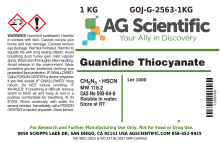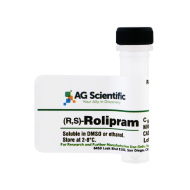9073-60-3
Water
2-8°C
beta-lactamases are enzymes produced by bacteria (Also known as Penicillinase) that provide resistance to β-lactam antibiotics such as penicillins, cephamycins, and carbapenems (ertapenem), although carbapenems are relatively resistant to beta-lactamase.
beta-lactamase provides antibiotic resistance by breaking the antibiotics structure. These antibiotics all have a common element in their molecular structure: a four-atom ring known as a β-lactam. Through hydrolysis, the lactamase enzyme breaks the β-lactam ring open, deactivating the molecule's antibacterial properties.
beta-lactam antibiotics are typically used to treat a broad spectrum of Gram-positive and Gram-negative bacteria. beta-lactamases produced by Gram-negative organisms are usually secreted, especially when antibiotics are present in the environment.
β-Lactamase is a freeze-dried product containing buffer salts and zinc. β-Lactamase-ES has a broad spectrum activity of complete inactivation over a broad range of cephalosporins and penicillins.
Advantages:
- Full inactivation of a broad range of beta-Lactams including the more resistant cephalosporins: Cefepime, Cefoxitin, Cefradine and Ceftazidime which other commercially available enzymes do not degrade as efficiently.
- Highly stable, retaining >90% of its activity after 4 hours at 50°C, means no need to compensate for loss of enzyme activity during media preparation for applications using sterile plates.
Applications:
- Testing sterility of blood cultures - Blood cultures are routinely prepared in order to test for bacterial infection. False negative results might be obtained where the blood sample contains antibiotics. Incorporation of β-Lactamase in the culture medium will overcome this problem when cephalosporins/penicillins are present.
- Testing for contamination of drugs by antibiotics - US Code of Federal regulations states that “If a reasonable possibility exists that a non-penicillin drug product has been exposed to cross-contamination with penicillin, the non-penicillin drug product shall be tested for the presence of penicillin” (21 CFR 211.176, Penicillin Contamination, FDA, BY-Lines No. 8 November 1977).
- Environmental monitoring of antibiotic manufacturing area.
- Sterility testing of Bulk antibiotics as described by US Pharmcopeia (USP) Chapter 71 and EP Section 2.6.
Activity:
- Sterile, ready to use vials: >50 units/vial
- Non-sterile, bulk: >2 U/mg powder
Specifications:
- Sterile, gamma-irradiated, pre-dispensed, vacuum sealed vials (in packs of 10) for speed and ease of use
- 1 KU is approximately 0.31 g
- 1 Vial is approximately 30-50 mg
- pH Activity Range: Active at ph 6.5 - 9.8
- Temperature stability: >90% at 50°C for 4 hours
- Bulk powder is not sterile, but has been filtered through a 0.45 micron filter prior to freeze drying.
Reconstitution Protocol for Sterile, Ready-to-Use Vials:
Reconstitute at 10 U/mL with sterile water. Sterile-filter through a 0.45 μm membrane filter into sterile media. For agar media, add to liquid agar medium at >40°C just prior to pouring agar plates.
Potency in Agar Medium: Use at 0.5 U/mL in agar plates for complete (100%) hydrolysis of all Beta-lactams.
Unit Definitiion:
One unit of beta-Lactamase activity is defined as the amount of enzyme that will catalyze the hydrolysis of 1.0 micromole of cephalosporin C per minute at 25°C and pH 7.0
One beta-Lactamase unit is equivalent to 600 Levy Units, 75 Pollock Units, or 91200 Kersey Kinectic Units
Sterility:
- beta-Lactamase vials are sterilized by gamma-irradiation. No detectable growth in Tryptone Soya broth at 20°C to 25°C or Thioglycollate at 30°C to 35°C for 14 days.
- Bulk powder is not sterile, but has been filtered through at 0.45 micron filter prior to freeze drying.
Additional Reading from AG Scientific:
- beta-Lactamase and Microbial Antibiotic Resistance
- Top 7 FAQs About beta-Lactamase
- beta-Lactamase Composition, Sterility & Stability
- beta-Lactamase Inhibitors in Anti-Seizure Research
0.1 lbs
Research or further manufacturing use only, not for food or drug use.




